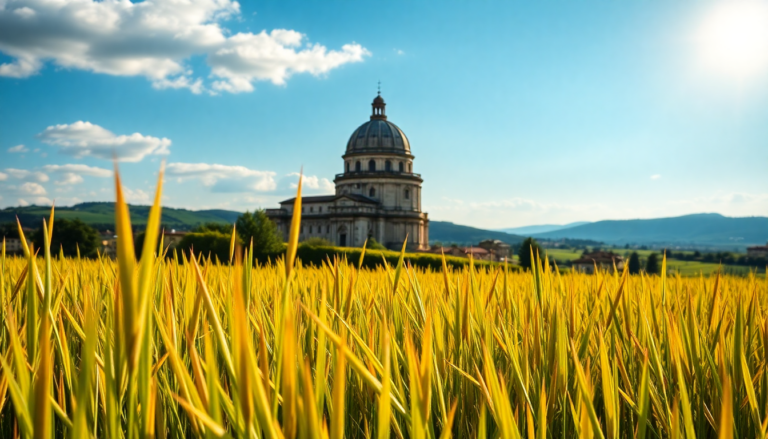Argomenti trattati
Nestled between the rice fields of the Po Valley and the rolling hills leading to Lake Maggiore, Novara is a city that often flies under the radar. With its rich Roman history and vibrant culture, it offers an escape into a world filled with art, architecture, and culinary delights. This guide will take you on a delightful journey through Novara, showcasing its must-see sights and local flavors that are sure to surprise and enchant.
The iconic dome of San Gaudenzio
One cannot visit Novara without being captivated by the magnificent Dome of San Gaudenzio, standing at an impressive 121 meters tall. Constructed between 1844 and 1888 under the visionary architect Alessandro Antonelli, famed for the Mole Antonelliana in Turin, this dome is a testament to 19th-century engineering. Its helicoidal and tapered form seems to defy gravity, making it an architectural marvel visible from miles away.
Ascending to the panoramic terrace offers breathtaking views of the city, the Alps, and the sprawling rice fields below. Inside the Basilica, visitors can admire exquisite Baroque decorations and a compelling crypt housing the relics of St. Gaudenzio, the city’s patron saint. Each January 22nd, locals honor him with a grand procession, a tradition that showcases the deep-rooted spirituality of the community.
Strolling through the historic center
Wandering through Novara’s historic center, visitors encounter cobblestone streets and serene corners leading to the Broletto, a refined medieval architectural complex. This ancient heart of Novara features four historic buildings: the Palazzo del Podestà, Palazzo dei Paratici, Palazzo del Comune, and the Loggia dei Mercanti, all surrounding an elegant Renaissance courtyard.
The Broletto has been carefully restored, revealing ancient decorations and medieval frescoes that transport visitors back in time. The courtyard, now accessible to all, is a picturesque spot perfect for a quiet pause between visits. Since 2016, the Broletto has also housed the Novara Art Museum, which showcases permanent collections of ancient and modern art alongside temporary exhibitions from both Italian and international contemporary artists.
Visiting the stunning cathedral
Just a short stroll from the Broletto brings you to the Cathedral of Santa Maria Assunta, another remarkable design by Antonelli. This neoclassical masterpiece features a bright and spacious interior adorned with significant elements, including the main altar and the Chapel of the Sacrament. Notably, the cathedral, along with its ancient Baptistery, encapsulates over 1500 years of religious architecture and culture.
The Baptistery is one of the oldest in Northern Italy, boasting 11th-century frescoes and representing a rare example of late Roman architecture. Inside, visitors can find medieval frescoes, including a rare depiction of Christ Pantocrator, surrounded by symbolic motifs related to baptism.
Shopping and local flavors
For those who enjoy shopping and the vibrant atmosphere typical of Italian cities, a stroll along Corso Cavour and Corso Italia is essential. Here, elegant boutiques, historic cafés, and artisanal shops line the streets, creating a charming environment perfect for a leisurely aperitivo of local gorgonzola and wine from the Novara Hills.
Corso Cavour, grand and monumental, is dotted with historic buildings and fashion boutiques, while Corso Italia presents a more bohemian vibe with artisan shops and quaint bistros. As you explore these lively streets, don’t forget to stop by one of the traditional pastry shops to savor a “margheritina di Stresa” or a sweet “paniscia,” a delightful local reinterpretation of a traditional dish.
The historic Visconteo-Sforzesco Castle
Few places tell the story of Novara quite like the Visconteo-Sforzesco Castle, an ancient fortress that has transformed into a cultural hub and community gathering space. Nestled close to the city center and surrounded by green gardens, this castle is a prime example of how medieval architecture can harmonize with contemporary vibrancy.
Originally fortified in the 13th century by the Visconti family, the castle was later expanded by the Sforza family in the 15th century. Its long and varied history has seen it serve as a ducal residence, military barracks, and now a venue for temporary exhibits, art installations, and cultural events. The castle’s square layout, corner towers, and inner courtyard still retain many defensive architectural features, now repurposed for modern uses.
Exploring the surrounding landscape
Beyond Novara’s urban charm lies a unique landscape that continually changes with the seasons, particularly the rice fields that form the heart of this agricultural region. Between April and June, during the flooding of the fields, the landscape transforms into a stunning “checked sea,” where the sky reflects in the water, and herons soar gracefully over the submerged rows.
This picturesque setting gives rise to the Rice Road, a gastronomic and cultural itinerary perfect for exploring the region authentically and sustainably. Travelers can navigate this route by car, bike, or motorcycle, discovering historic farms, working mills, and charming rural villages steeped in traditions passed down through generations.
The Rice Road is an invitation to experience local cuisine, with a must-try dish being the famous Novara paniscia. This hearty risotto, made with Arborio rice, salame della duja, cabbage, beans, onion, and red wine, tells the story of the region’s agricultural heritage and the conviviality of its peasant families.
Cultural experiences and nearby attractions
In addition to the Broletto Museum, the Faraggiana Ferrandi Natural History Museum is worth visiting, especially for families, along with the Novara Development Foundation, which hosts various art installations and performances. The cultural scene is vibrant, with events ranging from philosophy festivals to theater productions and photography exhibitions.
Novara also serves as an excellent base for exploring the surrounding area. Just a short drive away, you can find the romantic Lake Orta, the enchanting village of Orta San Giulio, and the UNESCO-listed Sacred Mountain. The Novara Hills, dotted with vineyards and wineries producing Nebbiolo and Ghemme DOCG, invite further exploration.

